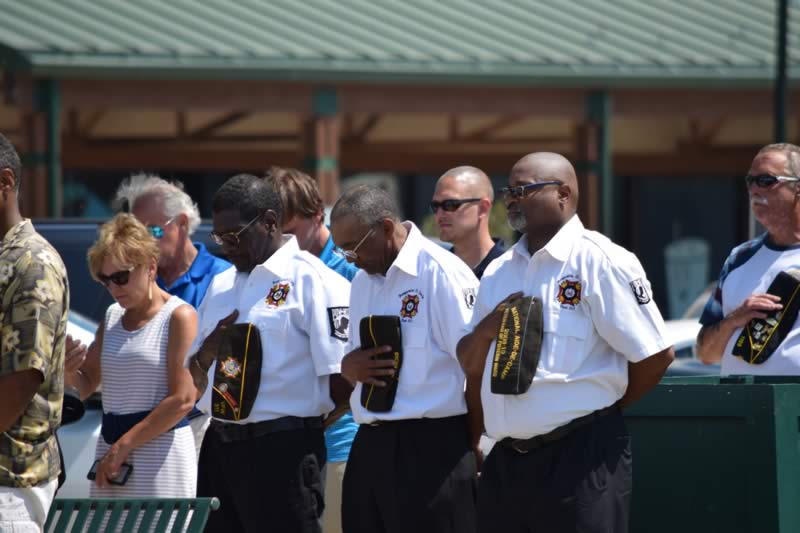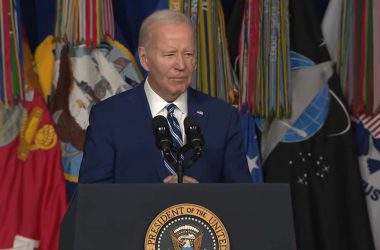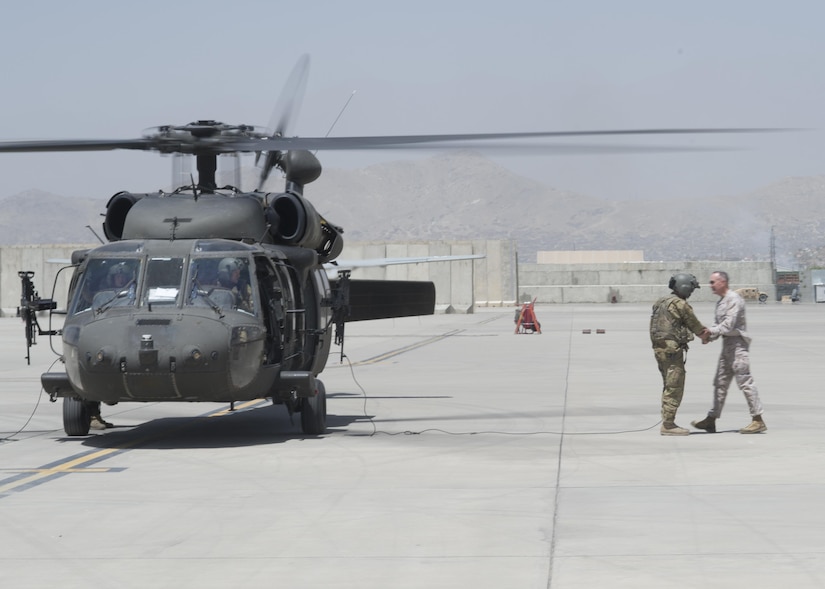Marine Corps Gen. Joe Dunford, chairman of the Joint Chiefs of Staff, departs Bagram Airfield in Afghanistan, July 16th, 2016. Dunford met with key leaders and received briefings about the progress of the Afghan air force as part of his overall assessment of the Resolute Support mission. DoD photo by Navy Petty Officer 2nd Class Dominique A. Pineiro
Washington, DC–(ENEWSPF)–October 21, 2016
By: Lisa Ferdinando
The Afghan national defense and security forces have made progress this year in the fight against the Taliban, but challenges remain, the Resolute Support mission’s deputy chief of staff for communications said today.
Briefing Pentagon reporters via teleconference from Kabul, Army Brig. Gen. Charles H. Cleveland said the Afghan government controls about two-thirds of the population, the Taliban controls or influences about 10 percent, and the remainder is contested.
The Taliban, Cleveland said, has set its sights on capturing provincial capitals this year before winter sets in, but Afghan security forces have been successful in thwarting those plans.
“While the ANDSF effort has not been always perfect and it has not always been pretty, they have been able to successfully defend each of their major population centers and each of their provincial capitals,” Cleveland said.
The last few weeks, he said, have reinforced that this is a tough fight. The Taliban is likely to try to overtake provincial capitals as winter approaches, he explained.
“We fully expect that the Taliban is absolutely going to take another run at Lashkar Gah and that could happen very soon,” Cleveland said, adding it could also try to overrun Tarinkot and perhaps another provincial capital.
“On top of that, we do still fully expect that we are going to see additional high-profile attacks here in the near future as the Taliban recognizes the end of the year is coming soon,” he said.
Condolences to Fallen Soldier, Army Civilian
Cleveland began the briefing by expressing condolences for a U.S. soldier and a U.S. Department of the Army civilian who were killed in an attack this week near a coalition base.
Army Sgt. Douglas J. Riney, 26, of Fairview, Illinois; and Michael G. Sauro, 40, of McAlester, Oklahoma, died Oct. 20 in Kabul, Afghanistan, of wounds received from encountering hostile enemy forces, according to a Defense Department statement.
They were conducting duties as part of the NATO mission to train, advise and assist the Afghan security forces, Resolute Support said in a statement earlier this week.
Kunduz Campaign Going Well
Cleveland said the real question about Kunduz was not if it would fall, but rather how long it would take to clear Taliban pockets out of the city.
The Taliban knew it could not take the city so it prolonged the fight, allowing it to garner media attention, as well as inflict additional suffering on the people, which would then increase pressure on the Afghan government, the general said.
The Taliban destroyed parts of the city, including the power grid, cell towers, and some civilian residences. The ANDSF successfully held and cleared the city, Cleveland said.
“It did take them a while, but those in the military do know that to try and clear an enemy out of an urban environment and not cause further destruction is a very difficult tactical problem,” he added.
Updates on Helmand, Farah Provinces
Helmand continues to be the Taliban’s main effort, he said, noting there is terrorist activity happening all over the province.
“What we’ve seen are these series of raids by the Taliban against checkpoints. We’ve seen them engage district centers, and then we’ve also seen them put some pressure on Lashkar Gah,” he said.
However, Cleveland pointed out, the Afghan security forces have successfully secured Lashkar Gah, which is the capital of Helmand province, and brought in additional reinforcements.
Separately, the Taliban thought perhaps it could have an “easy win” in Farah, the general said.
The Taliban did attack Farah City with the intent to try to capture it, but the Afghan forces were able to secure the city and now are pushing their security bubble out farther, Cleveland said.
Fighting the Islamic State of Iraq and the Levant
Cleveland highlighted the efforts against the Islamic State of Iraq and the Levant in Afghanistan, noting those operations dovetail with international counter-ISIL efforts.
There have been airstrikes against ISIL targets, he said, noting U.S. Special Forces have been put in advisory roles and moved along with commandos.
“We did conduct about three partnered raids with our Afghan partners, and those were to destroy [ISIL] command-and-control nodes,” he said.
The collective work has been successful, Cleveland said, noting ISIL’s end strength in Afghanistan has been reduced by 15 to 20 percent, with about 1,000 ISIL members remaining in the area.
Improved Afghan Security Forces
The Afghan security forces are on the offensive, and have improved their performance compared to last year, Cleveland said.
“There’s been gradual progress, and we see it at the tactical level, but we also see it is at the institutional level,” he said.
Yet, work remains, Cleveland pointed out.
“We do have a ways to go,” he said. “The ANDSF still has challenges and we’re going to continue to work with them to help them improve.”
(Follow Lisa Ferdinando on Twitter: @FerdinandoDoD)
Source: http://defense.gov









